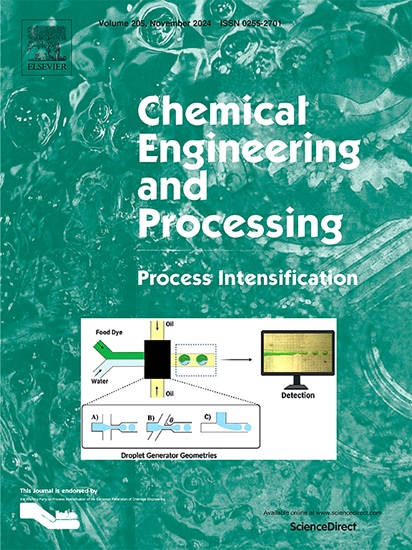可控制备三聚氰胺树脂微胶囊的强化传热研究:搅拌、滴注、喷涂和微通道固化工艺
IF 3.9
3区 工程技术
Q3 ENERGY & FUELS
Chemical Engineering and Processing - Process Intensification
Pub Date : 2025-07-03
DOI:10.1016/j.cep.2025.110433
引用次数: 0
摘要
微胶囊因其封装、输送和释放活性物质的能力而被广泛应用。虽然非离子型三聚氰胺树脂微胶囊具有良好的适应性和商业潜力,但其制备往往受到可控性差的阻碍。本研究采用过程剖析与强化相结合的策略,以固化过程为重点。通过红外光谱、粒度分析和计算流体动力学(CFD)模拟,对搅拌、滴/喷涂和微通道固化进行了系统评估。结果表明,高温破坏了三聚氰胺-甲醛预聚物之间的动态平衡,导致固化相不稳定。增强的传热有效地缩短了这段时间,减轻了诸如宽粒度分布、结块和团聚等问题。在所评价的方法中,微通道固化性能最好,颗粒均匀性显著提高(D50: 3.050 μm;跨度:3.36)相比于搅拌固化(D50: 32.329 μm;跨度:7.64)。结块和团聚现象基本消除,结块率降至1.58 mg/mL。本文章由计算机程序翻译,如有差异,请以英文原文为准。

Study of enhanced heat transfer on controllable preparation of melamine resin microcapsules: Stirring, dropping, spraying and microchannel curing process
Microcapsules are widely used for their ability to encapsulate, deliver, and release active substances. Although non-ionic melamine resin microcapsules offer excellent adaptability and commercial potential, their preparation is often hindered by poor controllability. This study adopted a strategy combining process dissection and intensification, focusing on curing process. The stirring, dropping/spraying, and microchannel curing were systematically evaluated using infrared spectroscopy, particle size analysis, and computational fluid dynamics (CFD) simulations. Results showed that elevated temperatures disrupted the dynamic equilibrium among melamine-formaldehyde prepolymers, leading to an unstable curing phase. Enhanced heat transfer effectively shortens this period, mitigating issues such as broad particle size distribution, caking, and agglomeration. Among the evaluated methods, microchannel curing delivered the best performance, with significantly improved particle uniformity (D50: 3.050 μm; Span: 3.36) compared to stirring curing (D50: 32.329 μm; Span: 7.64). Caking and agglomeration were nearly eliminated, with the caking rate reduced to 1.58 mg/mL.
求助全文
通过发布文献求助,成功后即可免费获取论文全文。
去求助
来源期刊
CiteScore
7.80
自引率
9.30%
发文量
408
审稿时长
49 days
期刊介绍:
Chemical Engineering and Processing: Process Intensification is intended for practicing researchers in industry and academia, working in the field of Process Engineering and related to the subject of Process Intensification.Articles published in the Journal demonstrate how novel discoveries, developments and theories in the field of Process Engineering and in particular Process Intensification may be used for analysis and design of innovative equipment and processing methods with substantially improved sustainability, efficiency and environmental performance.

 求助内容:
求助内容: 应助结果提醒方式:
应助结果提醒方式:


